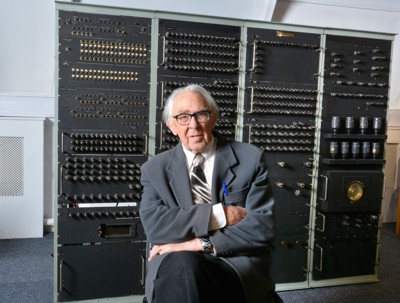| HEC 1950s Business Computer Goes On Display |
| Written by Sue Gee | |||
| Monday, 04 April 2016 | |||
|
The first version of the Hollerith Electronic Computer, Britain’s first mass-produced business computer which is notable for being based on a design by Andrew Booth and featuring his magnetic drum store, is now on display in the First Generation Gallery at The National Museum of Computing (TNMOC) on Bletchley Park.
Dr Raymond Bird and the HEC at TNMOC, April 2016 The HEC was commissioned in 1951 by the British Tabulating Machine Company, a company that also made Hollerith punch card systems which explains its name. Its design was based on Andrew Booth's All Purpose Electronic Computer and it included the innovative magnetic drum store which Booth pioneered. The HEC's dimensions are 1.5 m high by 3m wide by 0.5m deep. It has According to TNMOC: The HEC was the prototype for the range of computers that were to become Britain’s best-selling first-generation computer and, as the first computer installed in many countries including India, New Zealand and East Africa, the machine played a key role in starting the global computer revolution. Dr Raymond Bird, who engineered the original HEC and its subsequent models attended the event marking the opening of the display at TNMOC on April 2nd and provided its background history: “BTM was one of Britain’s largest suppliers of pre-computing punch-card systems and the company realised that computing was the company’s future. BTM had been approached by Professor Andrew Booth of Birkbeck College, London, who needed input and output technologies – punch cards – for a computer he was designing. A deal was struck and I was sent to make copies of Booth’s computer design." The place he went to, with two colleagues was a decrepit barn at the Booth family home in the Warwickshire countryside where Booth had built the APE (X) C, standing for All-purpose Electronic (X) Computer where X could be replaced by the name of the organization it was being built for. In just a few days Bird’s team had copied Andrew Booth’s circuitry in the APE (Rayon) C, built for the British Rayon Research Association. Returning to BTM’s factory at Letchworth they added extra I/O interfaces and named the resulting computer the Hollerith Electronic Computer, getting the HEC1 working by the end of 1951. BTM management decreed that the HEC would go to the Business Efficiency Exhibition in October 1953 and so a new machine, HEC2, was built in a smart metal cabinet suitable for public display. Dr Bird recalls setting up for the Business Efficiency Exhibition: “We worked throughout the night at Olympia to have the HEC ready – keeping a friendly eye on our competitors, Power Samas, who were working just as hard a few stands away. They were preparing an electronic multiplier and printer, but when they saw what we had, they had fear in their eyes! Our demonstration of the noughts and crosses game was a great success in showing the potential power of computers. This was probably the first time that a computer had gone on public display in Britain.”
Dr Bird with the HEC2 at the Business Efficiency Exhibition 1953 Bird realised that it was essential to manufacture a machine that was operationally compatible with BTM’s punch card equipment and at a price that was in line with existing pre-computing technologies.This led to the first production model, the HEC 2M of which eight were sold as the HEC2M, mainly for technical applications. The successor was the HEC4 which was a commercial data processing machine of which over 70 were sold in the UK and abroad. At the end of the 1950s this was the UK’s best selling computer by volume. After BTM merged with its competitor Powers SAMAS to form ICT, the HEC4 became the ICT 1200 range.
TNMOC trustee Kevin Murrell, who was instrumental in arranging the long-term loan of the HEC from Birmingham Museums Collection Centre, where it had been stored for many years said: “The HEC is a key addition to our collection of computers representing the time when Britain was at the forefront of the global computing revolution. Our skilled volunteers have been poring over the HEC to understand how it worked and to fully document it. At first we thought that we couldn’t possibly restore any of it to working order, but now some possibilities are emerging and we will be investigating those. Technically the HEC has some very interesting and innovative features. Instead of delay lines, it used a magnetic drum for memory. One of its legacies can be seen in many of today’s computers and in almost every smartphone – they use modifications of the Booth Multiplier algorithm, first deployed in the HEC.” The HEC is the product of Andrew Booth's pioneering design and Raymond Bird's engineering skills, together with the legacy of the Hollerith name. Now a machine that had languished in store for many years is on display to the public alongside other machines of the period: the ongoing reconstruction of the 1949 EDSAC computer and the original 1951 Harwell Dekatron / WITCH computer. More InformationBritain’s first mass-produced business computer The National Museum of Computing Related ArticlesHerman Hollerith and the punch card EDSAC Display Officially Opened World's Oldest Digital Computer Works Again WITCH Computer Gains Guinness World Record The Harwell Dekatron Computer (book review)
To be informed about new articles on I Programmer, sign up for our weekly newsletter, subscribe to the RSS feed and follow us on Twitter, Facebook, Google+ or Linkedin.
Comments
or email your comment to: comments@i-programmer.info |
|||
| Last Updated ( Monday, 04 April 2016 ) |




